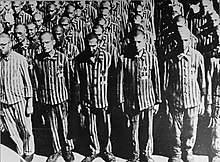Marking system in Nazi concentration camps
The Nazi concentration camps had a prisoner marking system based mainly on inverted triangles. The triangles were made of cloth and sewn onto the prisoners' jackets and shirts. These marks were mandatory and had specific meanings that served to distinguish the reasons for which the prisoner had been admitted to the camp.
Encoding
The shape was chosen by analogy with German traffic signs indicating dangers for drivers. The inverted is because the tip of the triangle points downwards and not upwards as usual.
The basis of the marking code was colors. Thus, different colors denoted different crimes or reasons:
- Yellow ▼ for Jews.
- Red ▼ for political prisoners.
- Green ▼ for common criminals.
- Blue ▼ for aliens.
- Purple ▼ for Jehovah's Witnesses and Bible-Free Students.
- Rosa ▼ for homosexual and similar men.
- Black ▼ Gemeinschaftsfremde ("come to the community") and Arbeitsscheu ("go, you do not like or cannot work"). This included gypsies, people with physical and intellectual disabilities, people with mental disorders, homeless, beggars, vagabonds, some lesbians (although there seemed to be a striking permissivity to the collective), prostitutes, inadaptated youth (youth swing), some anarchists, alcoholics and drug addicts.
- Brown ▼ later used for gypsies.
These triangles overlapped with a yellow triangle ▲ to denote prisoners as well as others offences They were Jews. In the case of the Jews, this was translated into a star of David or six points (Hexagram) yellow ![]() . This could occur even in the case of prisoners who had originally been institutionalized for any other reason, since according to the laws of Nuremberg were Jews all those who had Jewish ancestry.
. This could occur even in the case of prisoners who had originally been institutionalized for any other reason, since according to the laws of Nuremberg were Jews all those who had Jewish ancestry.
In addition to the color code, some groups had to put a letter in the center of the triangle to denote the country of origin:
- B for Belgians (Belgier).
- F for FrenchFfrogs).
- I for Italians (IMaybe.).
- J for Yugoslavs (Jugoslawen).
- N for Norwegians (Norweger).
- P for Poles (Polen).
- S for SpanishSicherheitsverwahrter —prison in pretrial detention — or Republikanische Spanier — Spanish republican— In Dachau, the Spanish republicans had the letters SP in its red triangle).
- T for Czechs (Tschechen).
- U for Hungarians (Ungarn).
- N for Dutch (Niederländer)
Other brands were:
- Number of interns.
- A bar on the triangle, of the same color as this, indicated recidivism.
- A black circle θ below the triangle indicated that the prisoner belonged to the punishment battalions.
- A symbol similar to the previous but with red core
 used for prisoners suspected of escape.
used for prisoners suspected of escape. - A red triangle ▲ indicated that it was belonging to the armed forces.
- A brown bracelet marked the prisoners special.
- Women accused of “interracial relations” (Rassenschänderin or Judenhure) were marked with a yellow inverted triangle (▼) on another black (▲).
- Men accused of “interracial relations”Rassenschänder) were marked with a black inverted triangular overflow (►) on a yellow triangle (▲).
There were many possible combinations. A prisoner usually had at least two marks, which could be as many as six.
Hierarchies in concentration camps
Brands classified wearers into a category, which led to a true hierarchy within the fields. The different groups had a very different consideration between the guards and prisoners.
- Violeta—prisons by religion: the direction of the camps appreciated them as servants above all to the Jehovah’s Witnesses for their good conduct. Still, many died from cold, disease, hunger or executions themselves.
- Red — political prisoners: political prisoners were particularly respected by other inmates.
- Green—common criminals: thirdly there were common criminals, who were often employed by vigilantes as "Kapos". Some became sadly famous.
- Two yellow triangles, that is, a yellow David star (
 ) — Jews: the Jews belonged to the despised prisoners and often suffered at the hands of the other prisoners.
) — Jews: the Jews belonged to the despised prisoners and often suffered at the hands of the other prisoners. - Black — "asocials": the associatives were still in a lower step and were particularly despised.
- Rosa — homosexual: this was the lowest step of the hierarchy of concentration camps and was despised and mistreated by all other prisoners.
Through this caste system, the control of the prisoners by the guards was facilitated, since they could even make life in the camp difficult by changing the prisoner's brand. Especially in the three lowest categories—Jews, “asocials,” and homosexuals—there are documented attempts by prisoners to get another triangle.
This hierarchy and categorization was used as a control system to avoid the formation of a large community among the prisoners.
After World War II, the treatment of the last two «castes», homosexuals and asocials, was often just as vexatious. The Landfahrerzentrale in Bavaria was a direct continuation of the SS-Zigeunerzentrale (SS headquarters for Gypsies), and there were homosexuals who went directly from concentration camps to prison.



